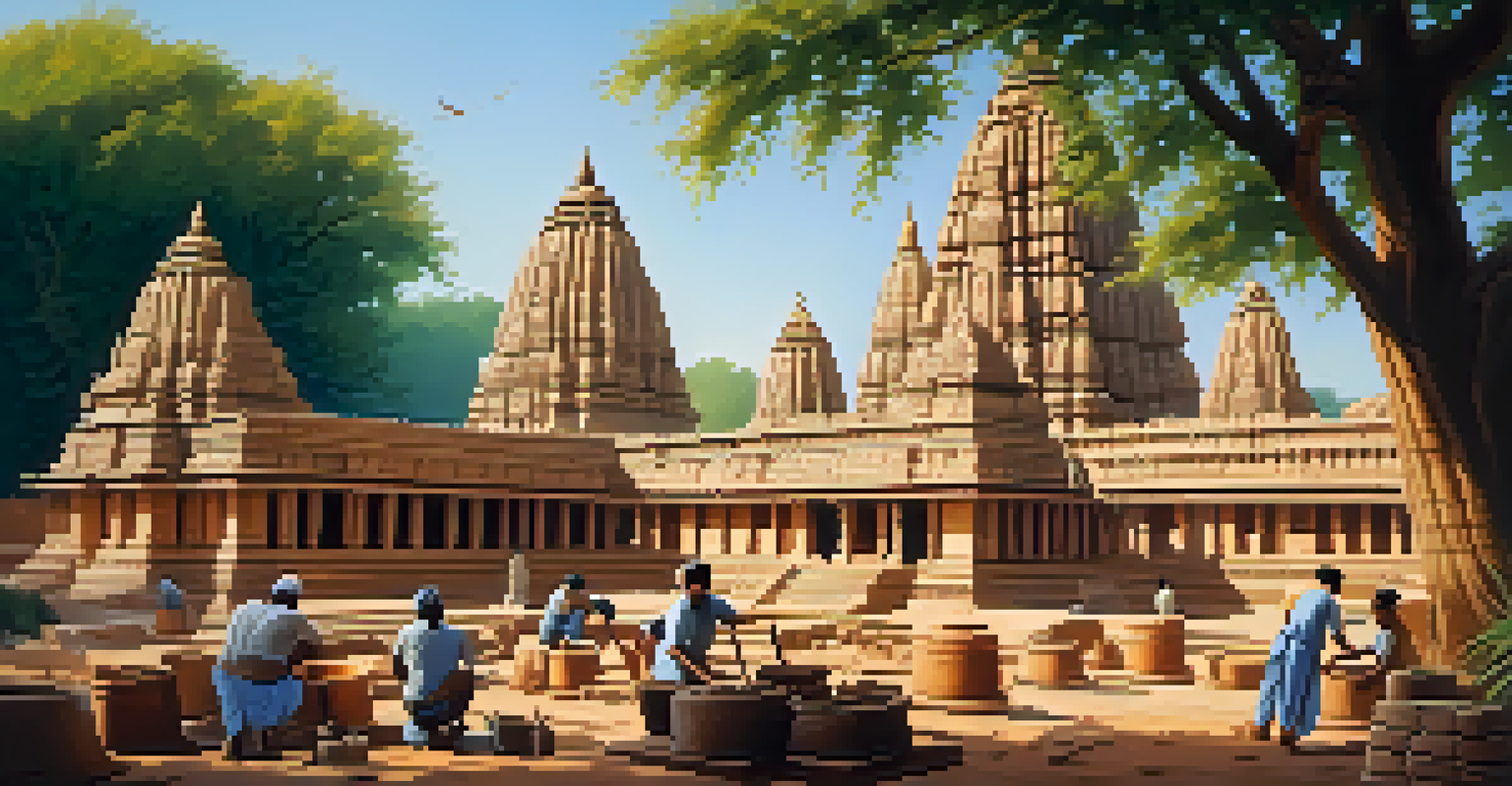Conservation Challenges Facing India's UNESCO World Heritage Sites

The Importance of India's UNESCO World Heritage Sites
India is home to 40 UNESCO World Heritage Sites, each a testament to the country's rich cultural and natural heritage. These sites range from ancient temples to breathtaking natural landscapes, showcasing India's historical significance and biodiversity. They not only attract millions of tourists each year but also serve as symbols of national pride and identity.
Heritage is our legacy from the past, what we live with today, and what we pass on to future generations.
However, the preservation of these sites is crucial, as they face numerous threats that could undermine their integrity. For instance, the Taj Mahal, an iconic symbol of love, is battling pollution and climate change that threaten its marble façade. Such challenges highlight the need for effective conservation strategies to protect these treasures for future generations.
Ultimately, safeguarding these sites goes beyond just preserving stones and structures; it involves protecting the stories and cultures they represent. By understanding their importance, we can better appreciate the urgency of addressing the conservation challenges they face.
Urbanization and Its Impact on Heritage Sites
Rapid urbanization is one of the most pressing challenges facing India's heritage sites. As cities expand, many sites find themselves enveloped by urban sprawl, leading to increased pollution and infrastructure pressure. For instance, the ancient city of Hampi, renowned for its ruins and landscape, is now threatened by encroaching modern development.

This urban growth often leads to the destruction of local ecosystems, which can have cascading effects on the heritage sites themselves. Noise and air pollution can degrade the physical structures, while increased foot traffic can erode delicate surfaces. The challenge, therefore, lies in balancing urban development with the need to protect these invaluable sites.
Preserving Heritage Amid Urban Growth
Rapid urbanization threatens India's heritage sites, necessitating a balance between development and conservation.
Addressing the impact of urbanization requires collaborative efforts between urban planners, conservationists, and local communities. By integrating conservation strategies into urban planning, we can create a sustainable environment where both heritage and modern life can coexist harmoniously.
Environmental Degradation and Climate Change Threats
Environmental degradation poses a significant threat to many of India's UNESCO World Heritage Sites. Natural disasters, such as floods and landslides, have increased due to climate change, endangering structures and ecosystems alike. For example, the Western Ghats, a biodiversity hotspot, face deforestation and habitat loss, which not only affects flora and fauna but also the cultural heritage tied to them.
Preservation of our heritage is not just about saving the past; it's about ensuring a sustainable future.
Moreover, rising temperatures and changing weather patterns can lead to irreversible damage to ancient structures. The intricate carvings of temples, like those at Khajuraho, are particularly vulnerable to erosion caused by heavy rainfall and humidity. As climate change continues to escalate, the urgency to address these environmental challenges becomes paramount.
To combat environmental degradation, innovative conservation practices must be adopted. These may include sustainable tourism practices, habitat restoration, and community engagement initiatives that promote awareness about climate change's impact on heritage preservation.
The Role of Tourism in Conservation and Challenges
Tourism plays a double-edged sword role in the conservation of India's heritage sites. On one hand, it generates revenue that can be reinvested in preservation efforts; on the other, the influx of visitors can lead to wear and tear. For instance, the historic city of Jaipur attracts millions of tourists annually, which can overwhelm its infrastructure and lead to degradation of its beautiful palaces and forts.
Managing tourism effectively is essential to mitigate its negative impacts. This includes implementing visitor limits, creating awareness programs, and promoting responsible tourism practices. By fostering a culture of respect for heritage, tourists can contribute positively to the conservation efforts rather than detracting from them.
Community Engagement is Essential
Involving local communities in conservation efforts fosters a sense of ownership and leads to more sustainable preservation practices.
Furthermore, sustainable tourism initiatives can provide local communities with economic opportunities, creating a vested interest in preserving their cultural heritage. When locals are empowered, the chances of successful conservation efforts increase significantly.
Funding and Resources for Heritage Conservation
Securing adequate funding for the conservation of UNESCO World Heritage Sites in India is a significant challenge. Many sites rely on government funding, which may not always be sufficient, especially in the face of competing priorities. For example, while the restoration of the Ajanta Caves is critical, funding may be diverted to other pressing social needs, leaving these cultural treasures vulnerable.
In addition to government support, private funding and international aid can play a crucial role in conservation efforts. Collaborations with NGOs and global organizations can help bridge the funding gap, ensuring that resources are allocated effectively. For instance, partnerships with UNESCO have led to successful restoration projects at sites like the Red Fort in Delhi.
Ultimately, creating a diversified funding model that includes community contributions, tourism revenues, and international grants can strengthen conservation efforts. By pooling resources, we can ensure that these sites are preserved for future generations to enjoy.
Community Involvement in Conservation Efforts
Engaging local communities in conservation efforts is vital for the sustainability of India's heritage sites. When communities feel a sense of ownership, they are more likely to protect and preserve their cultural heritage. For example, in the case of the Khajuraho temples, local artisans have been involved in restoration projects, fostering pride and awareness among residents.
Community involvement can also lead to innovative conservation solutions. Locals often have invaluable knowledge about their environment that can inform effective preservation strategies. By incorporating traditional practices and local insights, conservationists can develop more holistic approaches to safeguarding heritage sites.
Technology Aids Heritage Conservation
Innovative technologies like 3D mapping and drones enhance the documentation and preservation of heritage sites while engaging the public.
Moreover, educational programs that involve communities can spread awareness about the significance of heritage conservation. Workshops, school programs, and cultural events can inspire a new generation to value and protect their cultural inheritance.
Technological Innovations in Heritage Conservation
The advent of technology has opened new avenues for the conservation of heritage sites. Techniques such as 3D mapping and laser scanning allow for precise documentation and restoration of structures. For instance, the use of drones for aerial surveys has provided conservationists with valuable data about the state of sites like the Ajanta Caves, enabling targeted preservation efforts.
Additionally, digital platforms can enhance visitor experiences while promoting awareness of conservation issues. Virtual tours and augmented reality applications can educate the public about the significance of these sites, fostering a sense of responsibility toward their preservation. This tech-savvy approach can also attract younger generations to engage with cultural heritage.

However, it's essential to balance technological innovations with traditional conservation methods. While technology can provide powerful tools, the expertise of skilled artisans and conservators remains irreplaceable. A hybrid approach that combines the best of both worlds can lead to more effective and sustainable conservation outcomes.
The Path Forward: Sustainable Conservation Practices
As we look to the future, sustainable conservation practices will be key to protecting India's UNESCO World Heritage Sites. This involves not only preserving the physical structures but also ensuring that the cultural significance and community ties remain strong. Implementing strategies that prioritize ecological balance and cultural integrity can create a brighter future for these sites.
Moreover, fostering collaborations among government, NGOs, and local communities will enhance conservation efforts. By working together, stakeholders can share resources, knowledge, and best practices, ensuring that conservation is a shared responsibility. This collective approach can lead to more effective and enduring solutions.
In conclusion, while the challenges are significant, the commitment to preserving India's heritage must remain unwavering. With strategic planning, community involvement, and the integration of technology, we can ensure that these magnificent sites continue to inspire awe and pride for generations to come.